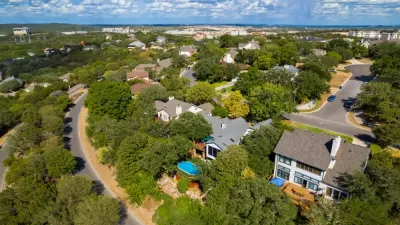Housing policy is not just about houses, it is also about people, and the determination of who may live in a community. We challenge communities to proclaim, “Yes in our backyard! We welcome new neighbors. We favor more diversity.”

My new report, Affordable Accessible Housing in a Dynamic City, provides 65 pages of detailed analysis concerning why and how to develop more affordable infill housing. That is too much information for most people to digest. I therefore boiled the key conclusions and recommendations down to a succinct statement titled, "Welcome To Our Neighborhood: A Manifesto for Inclusivity." Please let me know what you think.
- Todd Litman
* * *
Housing policy is not just about houses, it is also about people, and about who may live in a community. Many current policies favor more expensive housing, and therefore affluent residents, to the detriment of affordable housing and lower-income residents. This is inefficient and unfair. Social equity requires that urban neighborhoods welcome diversity, including lower-income households. We challenge communities to proclaim, “Yes in our backyard! We welcome new neighbors. We encourage more diversity.”
* * *
Everybody needs a home, a place where they belong, feel safe and comfortable, enjoy privacy and maintain a mailing address. However, many moderate- and lower-income households currently lack affordable housing, they are forced to spend more than their budgets allow, which imposes severe social and economic costs on individuals and communities.
What is affordability? It was originally defined as households spending no more than 30% of their budgets on housing, including rents, mortgages, property taxes, maintenance and basic utilities. However, since households often face trade-offs between housing and transportation costs (a cheap home in an isolated location is not really affordable due to high transport costs, and conversely, households can spend more for housing in accessible locations where transport costs are low) many experts now define affordability as housing and transport together costing no more than 45% of budgets.
For many households, affordability is best achieved with lower-cost housing types (apartments, townhouses and secondary suites) located in accessible neighborhoods with inexpensive travel options: good walking, cycling and public transit. Affordability therefore requires that markets respond to affordable-accessible housing demands: if more households want apartments, townhouses and secondary suites in accessible neighborhoods, public policies should support such development.
However, many current policies discourage affordable infill housing development. These include restrictions on development density and multi-family housing, plus excessive parking requirements. Such policies are based largely on myths and exaggerations:
- It is untrue that affordable infill housing increases crime and social problems. On the contrary, most low-priced housing residents are responsible workers, students and pensioners, and all else being equal, per capita crime rates tend to decline with neighborhood density and walkability, which increase community cohesion (people get to know their neighbors) and natural surveillance (residents keep an eye on each other, also called “eyes on the street”).
- It is untrue that affordable infill housing significantly increases traffic and parking problems. On the contrary, because residents of such housing tend to own fewer motor vehicles and generate fewer vehicle trips than they would in automobile-dependent locations, compact infill development tends to reduce regional traffic and parking problems, and local impacts can be mitigated through efficient management.
- It is untrue that higher density development tends to increase health problems. On the contrary, residents of more compact, multimodal neighborhoods tend to be fitter and healthier, and have lower traffic fatality rates, than residents of automobile-dependent sprawled areas.
- It is untrue that the infill development local impacts are entirely negative. On the contrary, infill development can support more local services, increase local business activity, increase safety and security, and provide housing that allows current residents to age in place when it comes time for them to move out of their single-family homes.
- It is untrue that the demand for lower-priced infill housing can be met with special programs, such as affordable housing mandates or funds. On the contrary, most latent affordable housing demand can only be met with policies that reduce the costs of developing inexpensive housing types such as townhouses, apartments and secondary suites.
Opponents of urban infill often express vague objections to density, but when asked for more specificity their actual concerns usually turn out to relate to design and management, such as building style, pedestrian access and parking congestion, impacts that can often be mitigated without reducing the number of people that new buildings can accommodate. By better understanding true neighborhood concerns about infill development, communities can develop better policies and planning practices.
Policy reforms to support affordable infill development are an act of generosity to lower-income households; a practical way to achieve economic, social and environmental objectives; and an act of self-interest since anybody, including people who currently own their homes, may someday need compact and affordable housing options.
Economic efficiency and social equity therefore require:
- Urban planning that supports infill development that accommodates diverse residents, including old and young, low- and high-income, working and retired, able and disabled.
- Policies that support development of affordable housing types, including townhouses, apartments and secondary suites, so nobody is forced to pay for more expensive housing than they need.
- Policies that support improvements to affordable travel modes, including walking, cycling, public transit and carsharing.
- Unbundled parking so nobody is forced to pay for more parking then they need.
- Efficient management of road and parking space to address any local traffic and parking problems.
* * *
Affordable-accessible housing development provides many economic, social and environmental benefits, and so can help connect diverse interest groups including business organizations that support housing development, environmental groups that want to reduce sprawl, public health professionals who support active transportation, and organizations that want to help disadvantaged households. Here are quotes that may be useful for faith-based groups:
“If there is a poor man among your brothers in any of the towns of the land that the Lord your God is giving you, do not be hardhearted or tightfisted toward your poor brother. Rather be open-handed and freely lend him whatever he needs.” - Deuteronomy 15
Free those who are wrongly imprisoned; lighten the burden of those who work for you. Let the oppressed go free, and remove the chains that bind people. Share your food with the hungry, and give shelter to the homeless. Give clothes to those who need them, and do not hide from relatives who need your help. - Isaiah 58

Maui's Vacation Rental Debate Turns Ugly
Verbal attacks, misinformation campaigns and fistfights plague a high-stakes debate to convert thousands of vacation rentals into long-term housing.

Planetizen Federal Action Tracker
A weekly monitor of how Trump’s orders and actions are impacting planners and planning in America.

San Francisco Suspends Traffic Calming Amidst Record Deaths
Citing “a challenging fiscal landscape,” the city will cease the program on the heels of 42 traffic deaths, including 24 pedestrians.

Defunct Pittsburgh Power Plant to Become Residential Tower
A decommissioned steam heat plant will be redeveloped into almost 100 affordable housing units.

Trump Prompts Restructuring of Transportation Research Board in “Unprecedented Overreach”
The TRB has eliminated more than half of its committees including those focused on climate, equity, and cities.

Amtrak Rolls Out New Orleans to Alabama “Mardi Gras” Train
The new service will operate morning and evening departures between Mobile and New Orleans.
Urban Design for Planners 1: Software Tools
This six-course series explores essential urban design concepts using open source software and equips planners with the tools they need to participate fully in the urban design process.
Planning for Universal Design
Learn the tools for implementing Universal Design in planning regulations.
Heyer Gruel & Associates PA
JM Goldson LLC
Custer County Colorado
City of Camden Redevelopment Agency
City of Astoria
Transportation Research & Education Center (TREC) at Portland State University
Jefferson Parish Government
Camden Redevelopment Agency
City of Claremont






























